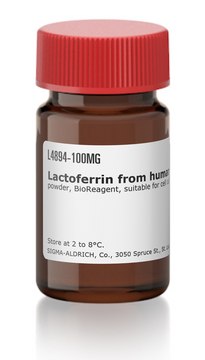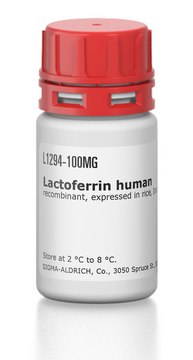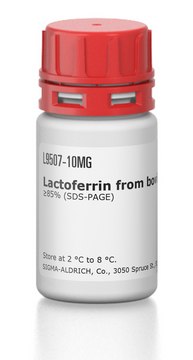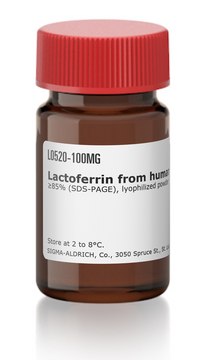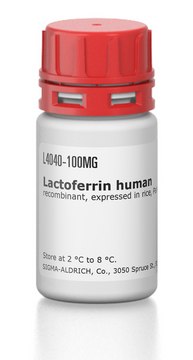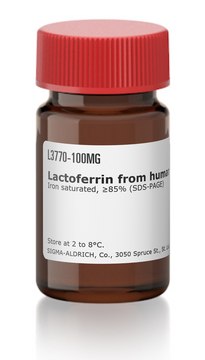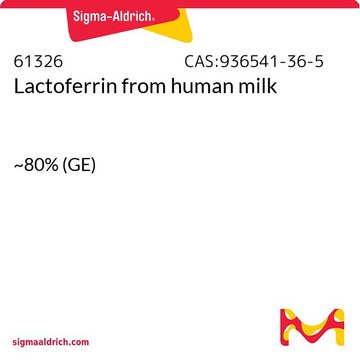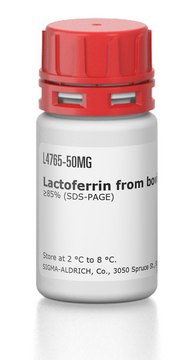SRP6519
Lactoferrin from human milk
≥95% (SDS-PAGE)
Synonym(s):
Lactotransferrin, Talalactoferrin
Sign Into View Organizational & Contract Pricing
All Photos(1)
About This Item
UNSPSC Code:
12352202
Recommended Products
General description
Lactoferrin gene is mapped to human chromosome 3p21.31.
Lactoferrin is a glycoprotein present in exocrine secretions and in the secondary granules of polymorphonuclear neutrophils. It is the iron binding protein in milk. Human lactoferrin belongs to the family of transferrins. It is found to be expressed in several glandular epithelial cells and skin epidermal keratinocytes.
Application
Lactoferrin from human milk has been used as a standard in standard curve generation for quantifying recombinant lactoferrin in enzyme-linked immunosorbent assay (ELISA). It has also been used as a positive control in sodium dodecyl sulfate (SDS)-polyacrylamide gel electrophoresis (PAGE ).
Biochem/physiol Actions
Lactoferrin is known to regulate intestinal iron absorption, and to participate in the defense against bacteria. It functions in the innate immune system via the activation of nuclear factor-κB (NF-κB). This activation occurs via Toll-like receptor 4 pathway due to the interference of lactoferrin with the lipopolysaccharide-stimulated TLR4 signaling. It serves as a ligand for low-density lipoprotein receptor-related protein 1 (LRP1) in human skin keratinocytes and fibroblasts. It is capable of stimulating cell growth in various cell lines. Lactoferrin is also found to participate in wound healing.
Physical form
Frozen in 50 mM Tris and 0.2 M NaCl, pH 8.0 .
Storage Class Code
11 - Combustible Solids
WGK
WGK 3
Flash Point(F)
Not applicable
Flash Point(C)
Not applicable
Regulatory Information
常规特殊物品
Choose from one of the most recent versions:
Certificates of Analysis (COA)
Lot/Batch Number
Don't see the Right Version?
If you require a particular version, you can look up a specific certificate by the Lot or Batch number.
Already Own This Product?
Find documentation for the products that you have recently purchased in the Document Library.
Susmita Ghosh et al.
International journal of cancer, 123(11), 2594-2604 (2008-09-17)
The aim of our study was to analyze the alterations of some candidate tumor suppressor genes (TSGs) viz. LIMD1, LTF, CDC25A, SCOTIN, RASSF1A and CACNA2D2 located in the chromosomal region 3p21.31 associated with the development of early dysplastic lesions of
Protective factors in milk and the development of the immune system.
Hanson LA
Pediatrics, 75, 172-176 (1985)
L Tang et al.
The British journal of dermatology, 163(1), 38-47 (2010-03-13)
Human lactoferrin (hLF), a member of the transferrin family, is known for its antimicrobial and anti-inflammatory effects. Recent studies on various nonskin cell lines indicate that hLF may have a stimulatory effect on cell proliferation. To study the potential role
Dzhangar Dzhumashev et al.
Cancers, 14(20) (2022-10-28)
Active drug delivery by tumor-targeting peptides is a promising approach to improve existing therapies for rhabdomyosarcoma (RMS), by increasing the therapeutic effect and decreasing the systemic toxicity, e.g., by drug-loaded peptide-targeted nanoparticles. Here, we tested 20 different tumor-targeting peptides for
Effect of chloroquine on cultured fibroblasts: release of lysosomal hydrolases and inhibition of their uptake.
U N Wiesmann et al.
Biochemical and biophysical research communications, 66(4), 1338-1343 (1975-10-27)
Our team of scientists has experience in all areas of research including Life Science, Material Science, Chemical Synthesis, Chromatography, Analytical and many others.
Contact Technical Service